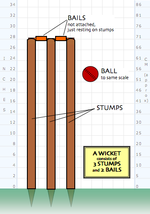
In the sport of cricket, a bail is one of the two smaller sticks placed on top of the three stumps to form a wicket. The bails are used to determine when the wicket is broken, which in turn is one of the critical factors in determining whether a batsman is out bowled, stumped, run out or hit wicket.
The wicket is considered to be broken if either or both of the bails fall from the stumps, or a stump is struck out of the ground, by:
This means, for example, that if the ball hits the wicket directly from the bowler's delivery, the batsman is only out bowled if a bail falls off, so a ball can actually brush or rest against the stumps without the batsman being out.
If a bail falls off the stumps for any other reason while the ball is still in play, and a later incident such as a run out attempt requires the wicket to be broken, then the other bail can be removed (if it has not yet fallen off), or a stump can be struck out of the ground or pulled up, as described above.
Each bail is made of a single cylindrically shaped piece of wood which has two smaller cylinders of wood protruding from each end. The large central cylinder is called the barrel and the smaller protrusions are the spigots. The spigots are of unequal length: the longer rests alone on one stump, while the shorter rests on the middle stump together with the short spigot of the other bail.
Special heavy bails made of denser wood (usually lignum vitae) are sometimes used in windy conditions if the normal light bails are likely to be blown off the stumps. The umpires can decide to dispense with the bails completely (for example, where strong gusts of wind would remove even the heavy bails), in which case the umpires will adjudge whether or not the wicket is broken.
the ball,
the striking batsman's bat, or any part of the striker's body or clothing (even if it falls off), or
a fielder with the hand or arm holding the ball. Quotation
An excerpt from Law 8(3)(b) of the Laws of Cricket:
Each bail shall conform to the following specifications:
- Overall length:- 4 5/16 in/10.95cm
- Length of barrel:- 2 1/8 in/5.40cm
- Longer spigot:- 1 3/8 in/3.49cm
- Shorter spigot:- 13/16 in/2.06cm
Overall length:- 4 5/16 in/10.95cm
Length of barrel:- 2 1/8 in/5.40cm
Longer spigot:- 1 3/8 in/3.49cm
Shorter spigot:- 13/16 in/2.06cm
No comments:
Post a Comment